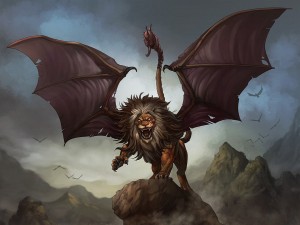“You will soon see exactly what your thoughts dream” – Vergil, Inferno 16:121
Geryon the Manticore guards the descent from violent to the fraudulent. As such, he maintains features that are the domain of each. His human head and leonine body alight in the realm of violence, while his reptilian spine and tail hang off the edge of a cliff. At the bottom of the cliff are the frauds.
Ancient Greek statue of Geryon
Of all the monsters of the Inferno, Geryon was the biggest challenge to draw. Dante’s gives a descriptive account of Geryon – but beyond that, the history of this monster is as chimerical as its identity. Geryon the Manticore has its beginnings in ancient mythology. The Hercules myth recounts him as a warrior with three heads. Another sees him as three headed with a serpent’s body – and that’s the closest one we have to Dante’s vision. Wikipedia sums it up best:
“According to Hesiod, Geryon had one body and three heads, whereas the tradition followed by Aeschylus gave him three bodies. A lost description by Stesichoros said that he has six hands and six feet and is winged; there are some mid-sixth-century Chalcidian vases portraying Geryon as winged. Some accounts state that he had six legs as well while others state that the three bodies were joined to one pair of legs. Apart from these bizarre features, his appearance was that of a warrior.”
Gustav Dore gave us a good approximation, but we knew a kindly old man’s face doesn’t gain the trust it used to. You could see how in Victorian times that face was so trustworthy, but not today.
 Looking up modern takes on the Manticore didn’t do us any good at all. Modern illustrations pit him as a Dungeons and Dragons style creature meant to spur your aggression to attack and win XP and gold loot. Unfortunately our friend Geryon does the exact opposite. He gains your trust with his kindly face, intimidates you with his overpowering physique, and once you’ve let your guard down, in comes the stinger.
Looking up modern takes on the Manticore didn’t do us any good at all. Modern illustrations pit him as a Dungeons and Dragons style creature meant to spur your aggression to attack and win XP and gold loot. Unfortunately our friend Geryon does the exact opposite. He gains your trust with his kindly face, intimidates you with his overpowering physique, and once you’ve let your guard down, in comes the stinger.
Fortunately for us literary types, we don’t have to go by pictures alone and could go by pure imaginings. I recalled Douglas Adams’ account of “lionized men”:
“Flare-riding is one of the most exotic and exhilarating sports in existence, and those who can dare and afford it are amongst the most lionized men in the Galaxy. It is also of course stupefyingly dangerous – those who don’t die riding invariably die of sexual exhaustion at one of the Daedalus Club’s Apres-Flare parties.” – Restaurant at the end of the Universe
Combine that with the lion’s mane of a glam rocker (who had comparable sex lives), and we would have an ideal starting point. Add the basic physics of Dore’s Manticore, and we’d have something.
And so we went, straight from imagination. I wish I still had my first chicken scratch version of our final Geryon, or any of the endless frustrating iterations we went through before we finally settled on one. There was one picture of a Manticore I missed that was rather interesting, it was a toothy businessman with a Cheshire cat smile.
And I hate to say that in the end, Jim couldn’t come up with a version that satisfied me, which was indeed a rare experience. So we went to a third party, Esmeralda Acosta, to help us out. I had a feeling a woman could get this concept better, they seem so used to dealing with charming frauds.
And that’s what led us to our final drawing. Even looking at it now, I’d say there’s some things I’d like to tweak (a more heartthrobby face?). But art is never so much finished as it is abandoned.
So we can see how the Manticore as we know it really has its roots in Dante. Other myths abound all the way back to ancient times, before even ancient Greece. But Dante modernizes it and gives it solid form that really brings out the nature of fraud.
Another interesting point about the Manticore is how Dante and Vergil summon it. In the Inferno, Dante has to throw his rope belt over the cliff to bring it up. There’s some debate as to what it means, but I had my definite take on it. Dante makes mention about how he was hoping to “snare the leopard” in the beginning of Inferno with this belt.
The leopard in the beginning represents the sins of lusty youth – gaudy pelt, showing off, prancing around with no real purpose or meaning. The pelt of the Manticore mirrors the pelt of the leopard. The belt is a cultural representation of chastity (like with the Party women in 1984) and so Dante was hoping through chastity to overcome that beast of sins of youth.
This is what made the Manticore really interesting to me. We just finished crossing the plains of sodomites, those who did violence to the sacredness of sexuality. And we are about to descend into the frauds, which have a distinct interest in exploiting sexuality. So the Manticore (with its lionized visage) would not be summoned unless we gave up our hope for a chaste monogamous life. If perhaps some of us go through it, it generally is a myth. Especially in these parts of hell.
So, while I did not have a belt, I had my locket. By tossing this down, I tossed down my own dreams of being reunited with my love in the flower of youth. Thus I would no longer disinterestedly pass by all I was now about to see.




Leave a Reply
You must be logged in to post a comment.